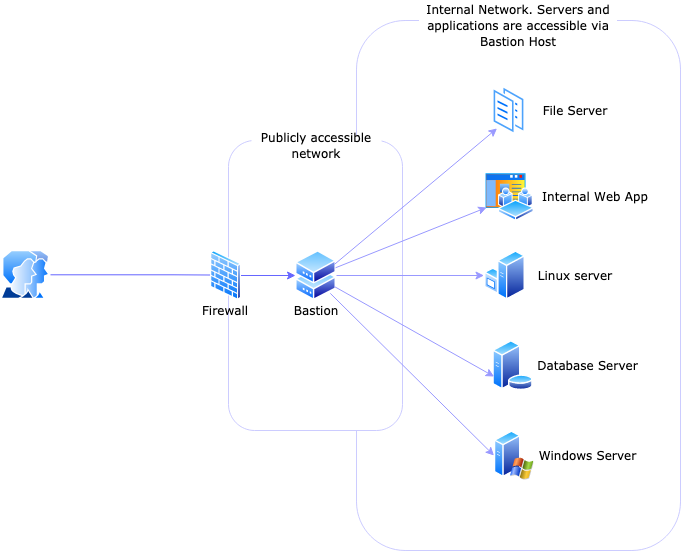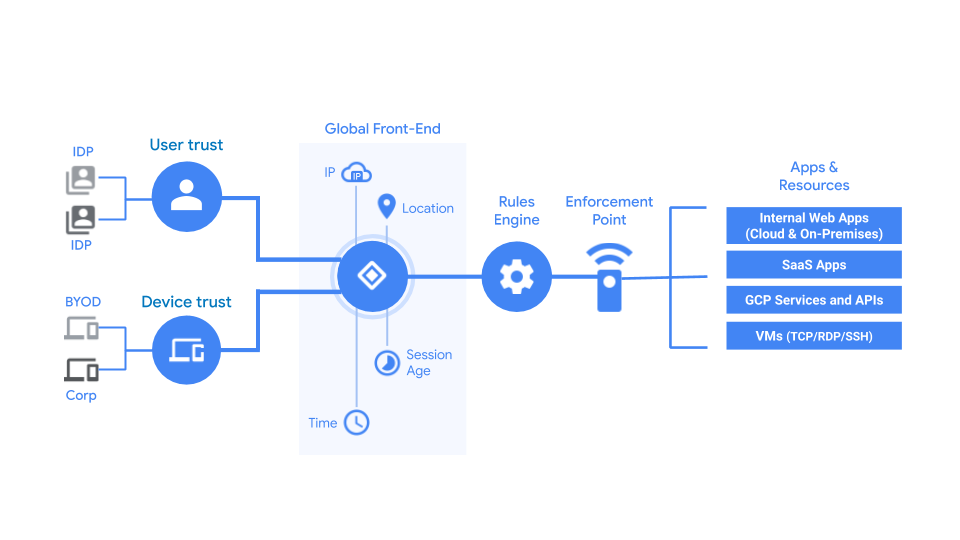Home - Teleport Blog - Do We Still Need a Bastion? - Sep 22, 2021
Do We Still Need a Bastion?

TL;DR - Yes! Bastions are still the recommended solution to manage secure remote access to cloud infrastructures.
There is a growing discussion among network engineers, DevOps teams, and security professionals about the security benefits of bastions. Many assume that they are the "old way" of network access and have little relevance in the modern cloud native stack. These speculations are not irrelevant as in recent years, the corporate IT network perimeter as we knew it is diminishing, and the concept has been shifted to data, identity, and compute perimeter. Software-defined networking solutions have overtaken hardware firewall boxes, and the requirement of managing bare metal servers has shifted to container deployed or even serverless applications. Where do bastions fit in these scenarios? Do we even need one?
A short primer on bastions
Bastions
By definition, bastions are a fortified checkpoint to counter or contain a threat. The concept of bastions can be applied to the real life fortification of a place or a building or a computer network.
Bastion hosts (Bastion 1.0)
Bastion hosts (also commonly called bastion servers) are typically configured with a bare minimum operating system with protocol-specific servers such as OpenSSH server or RDP gateway.
The term "bastion hosts" was initially used by Marcus J. Ranum in his 1993 article on the topic "Thinking About Firewall," where he discusses that a bastion host is a security-hardened server, which should be the strongest and the last checkpoint in a network before the access is allowed to the internal network or internally hosted application. Further, bastion host can itself be used as a firewall (a bridge to connect to internal network servers) or can host application services on top of its security-hardened system.


Although bastion hosts themselves provide good enough security to protect direct network access to servers and applications, they have the following shortcomings:
-
A bastion host requires a dedicated server to be managed. In a container vs. VMs debate, a requirement for managing a dedicated host can be a deal-breaker for smaller teams.
-
Challenges in extending bastion capabilities. Extending the capabilities of a bastion host to support multiple protocols or application support requires installing more dependencies. This may increase the attack surface of the host and defeat the purpose(one of which is reducing an attack surface) of the bastion host.
-
Lack of support for modern standardized authentication. Administrators prefer standard and secure features out of the box. There is no consistent way to create and configure a bastion host. Consider a case for SSH bastion — should you use agent forwarding or proxy jump or configure the PAM module to support out-of-band authentication?
Listn to this article
Bastion service (Bastion 2.0)
Bastion service is the new evolution of bastion hosts. A bastion service solves the shortcomings we mentioned above and brings more value in terms of manageability and security. Below are a few differentiators between a bastion host and a bastion service.
| FEATURES | BASTION HOST | BASTION SERVICE |
|---|---|---|
| Deployment type | Dedicated Linux server, VM, firewall | Platform agnostic. Supports cloud native workflow, can be ephemeral service, can deploy in Kubernetes, or offered as a PaaS. |
| Topology type | Generally attached to a single private network | Supports multi-cloud, multi-datacenter cluster allowing interconnected geo-spanned access points. |
| Components | Individual components to support multiple services (SSH, FTP, HTTP, etc.) | Single service that understands and accepts multiple protocols |
| Network Mapping | Private to Public network mapping | Public network to internal application and services mapping. |
| Transport Security | Can be plaintext transport | Only encrypted connections (mostly TLS) |
| Protocol Awareness | Network aware | Protocol and application privilege aware |
| Authentication | Network-based access control. Additional authentication depends on the service that is responsible for forwarding connections (e.g., SSH) | Primary access control integrated with corporate IAM. Supports client authentication, device attestation. |
Identity-aware access proxy in the BeyondCorp, Teleport, Azure Bastion service are few examples of Bastion service.
Bastions are not only for SSH!
Before we conclude the primer on bastions, it is important to mention that Bastions are not only for SSH. Most of the time, people relate to bastion host as an SSH jump server, which is correct but does not cover all use cases. While a Linux server configured with OpenSSH (setup as SSH Jump server) is a typical example of a bastion host, a bastion can sit in front of any protocol. For example, you can use a bastion for database access, RDP access, internal web application access. In fact, any internal endpoints which should not accept direct network access should be placed behind a bastion for extra security.
Quick security wins with bastions.
When you want to allow remote access to internal servers and applications securely, adding bastions in front offers security to a great extent. Below are a few quick security wins when using a bastion.
Bastion makes compliance easy
Every security compliance standard that deals with infrastructure access (e.g., FedRAMP AC-17 - Remote Access, HIPAA §164.312(a)(1) - Access control, SOC2 CC6.1 - Manage Points of Access) mandates to prevent direct network access to the servers and APIs. Bastions are the safest concept to address these controls.
Reduced attack surface
Few hardened access points are better than the "allowAll" setup. Configuring networks such that bastions are the only way inside helps reduce the attack surface.
Containing network access threats
When a remotely exploitable vulnerability is discovered, it becomes challenging to contain threats without affective server uptime. Using network firewalls and bastions together helps significantly to contain such threats. You can configure bastions such that internal teams (security, DevOps) can access the affected server while all other access is blocked.
Defense in depth
Even if the application behind supports strong authentication and authorization schemes, adding a security-hardened bastion in front ensures defense in depth. You'll have one additional endpoint to block or contain threats.
Keep script kiddies and bots at bay.
Script Kiddies love automation and firing tools randomly at public IPs. Moreover, there are bots constantly hammering on ports. Using bastions ensures that your primary servers do not waste valuable computing resources on processing cryptic connection requests.
Common bastion misconceptions
Although the capabilities of bastions have evolved (from bastion hosts to bastion services), many professionals still compare the old capabilities of bastion hosts (e.g., a Linux box with iptables and OpenSSH configured) with modern DevOps practices. This is the primary source of misunderstanding the importance of bastions.
Below, we will try to address common misconceptions related to bastions with reference to the capabilities of modern bastion services.
Bastion does not fit in immutable infrastructure and NoOps.
Immutable infrastructure is a fantastic concept. Many immutable infrastructure advocates suggest disabling SSH altogether such that troubleshooting tasks should be performed at the observation layer (logs, telemetry), and completely new infrastructure should be provisioned for patches and updates. Although the pros and cons of this method are out of topic for this article, it is essential to note that such an environment is not an easy task to manage itself. For emergencies or hotfixes, the ability to quickly access the server, debug and fix wins most of the time, so many teams still manage SSH access for break-glass access. And for managing secure SSH access, nothing beats a security-hardened bastion!
Further, recall that bastions are not only for SSH. So even if your infrastructure is fully immutable, you will need to protect access to observability dashboards, and a bastion's services are recommended ways to secure access.
Bastion gives a false sense of security.
Many professionals claim that using bastions will make you think access to internal servers is foolproof, but hackers will find a different path to your network, bypassing the Bastion. It's true; for when an attacker is determined, they will find a way in, one way or another. But security is about defense in depth, and having good security controls in place keeps 99% of script kiddies and bots at bay.
Use a firewall instead of a bastion.
In a proper network configuration, you should use both a firewall and a bastion. Although firewalls have made much progress in packet inspections and understanding HTTP protocols, it is still far from understanding other protocols such as database wire protocols or technology-specific nuances such as Kube API. Thus, you will still need a bastion host and run a proxy service or a modern bastion service to control access at the protocol level.
We use a VPN server.
When you implement a VPN for remote access, the VPN server acts as a bastion host for your network. In this case, you are only trading between a bastion server that allows secure network tunneling (a VPN server) vs. a bastion service that supports encrypted network (TLS) with better AuthN, AuthZ, and protocol-level awareness. Further, bastion services like Teleport offer a reverse tunneling feature to manage secure access to services behind a firewall and NAT without the need to open servers to a public routable interface.
Bastion is an “additional server" to maintain.
The trade-off between "extra server" to maintain vs. security benefits it provides are entirely worth it. Further, modern bastions are offered as a service that can be provisioned on an existing Kubernetes cluster or as an ephemeral service, meaning no need to manually set up and maintain a server.
Bastion has no place in a perimeter-less zero-trust world.
Funny how marketers have come to this conclusion. We mentioned earlier that the core technology of BeyondCorp (one of the first practical implementations and an industry-leading zero trust access solution by Google), which is an Identity-Aware Access Proxy (IAP), is by definition a bastion service. Also, see Zero Trust Network Access (ZTNA) which mentions a "trust broker that verifies the identity, context, and policy adherence of the specified participants before allowing access and prohibits lateral movement elsewhere in the network while hiding application assets from public visibility". The trust broker, in this case, is by nature a bastion service.


Fig: BeyondCorp architecture reference from Google. In the above case, the global front-end acts as a bastion service.
Services like AWS SNS, GCP BeyondCorp are better alternatives.
If all of your requirements for remote access can be achieved using these services, then using a bastion may not be a use case for your team. But since these services are platform-specific, it might not be relevant if you self-manage your infrastructure outside public clouds or have multi-cloud strategies.
Modern applications already support strong AuthN and AuthZ. So adding a bastion in front is just a bloat in the network.
It's quite the opposite! Along with defense in depth, bastion also enables centralized logging, auditing and helps you unify AuthN and AuthZ events across your infrastructure. It also becomes much easier to maintain and enforce fine-grained access control rules in a small pool of bastions rather than individual applications. So rather than bloat, we believe bastion-based network design helps manage large infrastructure with proper security controls.
Our small dev team or dev-staging environment does not require complications of the bastion.
"Attack them where they are unprepared, appear where you are not expected" Sun Tzu Art of war
Exploiting a development (or staging) environment and pivoting to the production environment is one of the favorite attack methods for hackers. Many data breaches start by exploiting an easy target, dev, and staging environment often neglected for security! In addition, production data is often pulled into dev servers (insecure practice), so skipping security practices in development environments does not make any sense.
When would you genuinely not require to use a bastion?
There are some situations where using bastions may not be relevant.
- Your organization only uses SaaS apps, and there is no infrastructure to maintain.
- Your organization's infrastructure access requirements are limited, and you can get all the features from available platform-specific products such as AWS SNS.
Teleport cybersecurity blog posts and tech news
Every other week we'll send a newsletter with the latest cybersecurity news and Teleport updates.
Conclusion
Although the dynamics of managing and operating cloud infrastructures have changed, bastions have also evolved a long way featuring capabilities such as user identity-aware and connection protocol-aware access proxy. These features are core components of the zero trust access paradigm. In addition to security benefits such as meeting compliance requirements and implementing defense in depths, modern bastion services are easy to deploy and adapt to DevOps culture. Providing ease of management without compromising on security and compliance, bastions are still the best and safest solutions to manage secure access to cloud infrastructures.
Try Teleport: Teleport allows engineers and security professionals to unify access for SSH servers, Kubernetes clusters, web applications, and databases across all environments. Deploy Teleport today as a bastion service to secure access to your cloud infrastructure.
Tags
Teleport Newsletter
Stay up-to-date with the newest Teleport releases by subscribing to our monthly updates.

Subscribe to our newsletter

